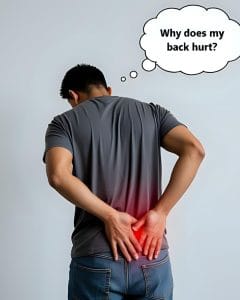
By Dr. Abigail Lindo, Registered Physiotherapist
Lower back pain is one of the most common health complaints in the world. According to the World Health Organization, about 619 million people had lower back pain in 2020. That number is expected to rise to 843 million by 2050.
For some people, the pain is mild and goes away quickly. For others, it can be sharp, constant, or even disabling. So what is behind this kind of pain, and what can be done about it?
What Causes Lower Back Pain?
Lower back pain can happen for many reasons. Understanding the cause is the first step to managing the pain and preventing it from getting worse.
Doctors usually group the causes into three main types
- Problems with muscles and bones
• Nerve-related issues
• Underlying health conditions or diseases
Muscle and Bone Problems
This is the most common cause of lower back pain. It includes injuries, age-related changes, and structural problems in the spine.
Some examples include
- Muscle strain from lifting, twisting, or overuse
• Ligament sprains, which happen when the tissues that hold bones together are stretched or torn
• Arthritis of the spine, also called spondylosis, which happens when the joints and discs in your back wear down over time. This can lead to stiffness, especially in the morning, and a dull ache that may improve as you move throughout the day.
Other spinal conditions to be aware of include
- Spondylolysis. This is a small crack or stress fracture in one of the bones in the spine. It often develops in teenagers or athletes due to repetitive stress or overuse.
• Spondylolisthesis. This occurs when one of the bones in the spine slips out of place and moves forward over the bone below it. It can cause pain, stiffness, or nerve pressure.
These conditions can range from mild to severe. In some cases, the pain may be relieved with rest, gentle stretching, or medication. In others, further treatment may be needed.
Nerve-Related Causes
Sometimes back pain happens because the nerves in your spine are being pressed or irritated. This can cause sharp pain, tingling, numbness, or even weakness in the legs.
Some examples include
- A slipped or herniated disc, when the soft cushion between the bones in the spine pushes out and presses on a nerve
• Sciatica, which causes pain that travels from the lower back down the leg
• Spinal stenosis, a condition where the space around the spinal cord becomes too narrow and puts pressure on the nerves
These symptoms may get worse when sitting, bending, or standing for long periods.
Health Conditions That Affect the Spine
In some cases, lower back pain is caused by other medical conditions. These are less common but may be more serious
- Certain types of arthritis that cause inflammation and stiffness in the spine
• Infections in the bones or discs of the spine
• Cancer that has spread to the spine
• Osteoporosis, a condition that makes bones weak and more likely to break
If you have back pain that is severe, constant, or comes with other symptoms like fever, weight loss, or night sweats, you should see a doctor right away.
How Is It Treated?
In most cases, lower back pain improves with simple care such as gentle movement, rest when needed, pain relief medication, and avoiding heavy lifting.
However, if the pain does not improve or your doctor suspects something more serious, you may be referred for
- Imaging tests like an X-ray, MRI, or CT scan to look more closely at the bones, discs, and nerves in your spine
• Bracing, which may help support your back and reduce movement, especially in cases like spondylolysis or spondylolisthesis
• Physiotherapy, where a trained professional will guide you through exercises to strengthen your back, improve flexibility, and relieve pain
In rare cases, if the condition is severe or does not improve with other treatments, surgery may be considered.
Lower back pain is very common, and most people recover with the right care. Understanding the cause is important, especially in conditions like spondylolysis, spondylolisthesis, or spondylosis.
If the pain lasts more than a few weeks or keeps you from doing daily activities, talk to your doctor. Getting help early can make a big difference in how quickly you feel better and get back to doing the things you enjoy.


Leave a Comment